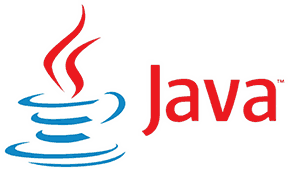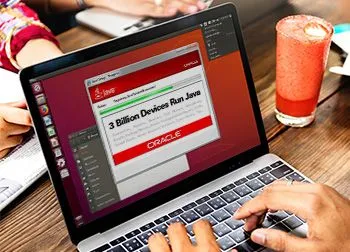Java language
Understand Java language, its features and what makes it one of the most widely used programming languages in computer history!
11/09/2023
Introduction

Originally released in 1995 by Sun Microsystems, the Java language is one of the most famous programming languages and most used by novice developers. In the software development market, Java is widely used due to its great implementation power, greater ease of use and smallest learning curve.
Currently the language belongs to the Oracle company and remains very strong. It still emerges as first in the rankingof the most used programming languages in the world (according to the TIOBE index).
But why is she so famous? Why did it work so well in the market? What makes it so used by most application developers?
To answer these questions we need to know the characteristics of this programming language.
Java works anywhere!
Java is a multiplatform programming language. This means that the programmer writes a single source code for his program and can run it on many different operating systems without almost any adjustment or adaptation. This is the concept we call portability: the ability to be portable and adapt to other environments in a natural way. In short: The programmer writes the code only once and executes it anywhere.

Java works on Windows

It works on the Linux system

Works on your Android phone

It even works on Mac OS
But it does not happen by magic. Greatly responsible The major responsible for giving language this ability to adapt to many different environments is your Virtual Machine.
A program written in Java is not run directly by the operating system, as traditional programs do. There is an application called Java Virtual Machine (JVM) that makes a program written in the language adaptable to many different types of systems.
The image below illustrates the role of the JVM. It acts as a kind of intermediary between running Java code and the operating system. The program code you have written is of course interpreted by the Virtual Machine and runs on various operating systems. All work on adapting to the system’s particulars is done by the JVM.

The JVM does not need to be configured by the programmer. It can be obtained for free from the Oracle website and is ready to use and interpret programs written in the language.
Are Java programs fast?
Despite portability and adaptability to various operating systems, Java applications are a bit slower than traditional applications. This is because the JVM, in its process of interpreting the program written in Java for the operating system, loses some processing performance.
Applications created in Java are not compiled and run in the traditional way. They are interpreted, and the meaning of this is a bit complex to be further elaborated here in this article. But, as simply as possible to explain, this means that the JVM reads the program code and interprets it to the operating system, and this interpretation process consumes a lot of computational resources. As if the JVM had to make an extra effort to run the program.
For this reason, real-time applications (those that need a lot of performance), for security reasons, do not use the Java language. Applications such as top 3D digital games, high reliability surgical medical systems and high precision industrial machine systems are not developed in Java as they require the highest possible performance of the computational system. Performance that the JVM cannot deliver.
On the other hand, softwares such as mobile applications, business systems, corporate systems, text editors, messaging applications, and all types of software whose high processing is not a priority can take advantage from development easiness of the Java language.
For example: a business application for a service company can be accelerated if it is written in Java, besides the fact that possible future modifications can be delivered much faster and easier.
What can you create with Java?
You can create the most diverse types of Java applications, such as enterprise systems, web systems, embedded device systems, to name a few. However, without a doubt, the most developed types of applications currently using the Java language are applications for the Android system.

Smart TV Applications

Embedded systems in home appliances

Enterprise and web systems

Android apps
Since the beginning of the smartphone revolution, the demand for applications has been growing absurdly, and in this context, the Java language has positioned itself very prominently. The universe of possibilities that applications have created for professional developers, hobbyists developers and enthusiasts alike has made the Java the most important development language for the Android operating system.
These days, there are other languages and technologies that allow you to develop Android apps such as C# and Kotlin. But the Java language is still Google’s official language for developing applications for its smartphone operating system.
Java is not Javascript!
Java is for JavaScript just as Fire is for Fireworks. [Laughs…]
Despite the similarity of the name, the Java and Javascript languages are quite different. They even have some syntactic similarity in some programming constructs, but they are completely different in purpose and manner in which they are executed.
Unlike Java, which is a language for developing a wide range of professional applications, Javascript is a scripting language designed for the Internet. Along with HTML and CSS, Javascript is one of the top three web technologies. It is built to provide website and web system developers with smarter ways to embed dynamic content into pages.
Another difference between Java and Javascript is in the execution of your applications. A Java application is written to a text file, then interpreted and executed by the JVM. Javascript is written in a script file, or directly in the HTML page, then interpreted by the web browser.
See below two examples of simple Java and Javascript code.
1.function hello() {
2. return "Hello Javascript!";
3.}
1.public class JavaClass{
2. public static void main(String[] args){
3. System.out.println("Hello Java!");
4. }
5.}
Is it worth learning?
he answer to this question is: yes. Java still one of the most used programming language in the world and, as we saw in this article, there is a huge universe of possibilities in areas where the programmer of this technology can work.
If we stop to think about the plethora of technologies and applications that use Java, it is clear to imagine the vast amount of opportunities that this technology provides. Especially in a world that is on the rise of technology and increasingly in need of new technologies.
David Santiago
Master in Systems and Computing. Graduated in Information Systems. Professor of Programming Language, Algorithms, Data Structures and Development of Digital Games.